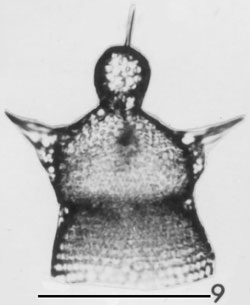|

|
|
Lipmanella dictyoceras
(Haeckel, 1861)
|
Description - Add description
Benson, 1966, p. 417-419; pl. 28, figs. 8-10:
Dictyoceras acanthicum Jørgensen
Dictyoceras acanthicum Jørgensen, 1900, Bergens Mus. Aarbog (1899), p. 84; 1905, Bergens Mus. Skrifter, p. 140, Pl. 17, fig. 101a; Pl. 18, fig. 101b.
Dictyoceras xiphephorum Jørgensen, 1900, Bergens Mus. Aarbog (1899), pp. 84-85, Pl. 5, fig. 25; 1905, Bergens Mus. Skrifter, p. 140.
Cephalis spherical, smooth to rough, generally without accessory spines, with small equal, circular, hexagonally arranged pores; separated from a campanulate thorax by a distinct collar stricture. Apical horn originates from the top of the cephalis but dorsally, straight to curved, vertical, generally thin, conical, but three-bladed in a few tests, in several specimens forked distally, extends from the apical bar which is an internal, eccentric columella. Vertical spine three-bladed to conical, originates from the collar stricture. Four, small, circular collar pores separated by heavy bars and surrounded by a heavy collar ring. Dorsal and primary lateral bars extend as ribs in the thoracic wall that are prolonged into generally three-bladed, heavy, proximally latticed, wing-like spines which originate from about the middle of the thorax. The spines vary from straight to curved, from divergent downward to nearly horizontal to curved upward. A subcylindrical to slightly inflated abdomen separated from the thorax by a deep constriction which is generally occupied by an internal septal ring, although one specimen observed with a broad shallow constriction without a septal ring. Basal margin
of abdomen incomplete. Pores of thorax and abdomen similar--subequal, circular to elliptical, subhexagonally arranged in approximate transverse rows. Surface of thorax with scattered, thin, conical spines; abdomen generally smooth.
Measurements; based on 15 specimens from stations 46, 60, 81, and 151: length of cephalis 25-28 µm, of thorax 53-80 µm, of abdomen 37-89 µm; breadth of cephalis 26-33 µm, of thorax 79-114 µm, of abdomen 82-123 µm; length of apical horn 18-55 µm, of vertical spine 6-20 mm, of basal spines (solid distal portions) 22-52 µm.
Remarks. Most specimens of this species from the Gulf have heavy, three-bladed basal spines and, therefore, are more like Dictyoceras xiphephorum Jørgensen which differs from D. acanthicum Jørgensen in the presence of more strongly developed basal spines. Jørgensen (1905, p. 140) admits that the two species may be the same, the latter representing a younger ontogenetic stage. In the Gulf specimens, the heaviness of the basal spines is variable and, therefore, not a good criterion for separation of species. Because D. acanthicum has page priority over D. xiphephorum it becomes the nominal species. Both of Jørgensen's species have numerous, long, thin, conical spines originating from the cephalis, whereas the cephalis of the Gulf specimens is generally smooth. Both, however, have accessory spines originating from the thorax. Whether or not, Lithopilium sphaerocephalum Popofsky (1913, p. 380, Pl. 35, figs. 2, 3) is identical with the Gulf species must await examination of Popofsky's type material. This species has numerous short, thin, convex outward bars joining the abdomen and thorax and aligned along the constriction between these two joints.
Distribution. This species is cosmopolitan in the Gulf, occurring as far north as station 208. It is rare at all stations where it is present and is absent at stations 27, 90, 130, 194, 203, 206, and 214. It has a slightly but not significantly greater average frequency in the southern half of the Gulf, but its general occurrence throughout the Gulf indicates its equal affinity for both Pacific and Gulf waters. Its absence at most of the marginal localities indicates its preference for offshore, more nearly oceanic waters. It does not appear to respond to upwelling, but its presence at station 208 which is located near the northernmost diatomite facies suggests some control by this mechanism.
Jørgensen (1905, p. 140) states that both Dictyoceras acanthicum Jørgensen and D. ziphephorum Jørgensen occur rarely and sparsely, always in deep water samples of Norwegian fjords and are rare off the west coast of Norway. This species, therefore, is apparently cosmopolitan, being present in the North Atlantic as well as in tropical eastern Pacific waters and the Gulf of California. Lithopilium sphaerocephalum Popofsky (1913, p. 380) is present in the western tropical part of the Indian Ocean.
| | Benson 1966 |
|
|
 |

|